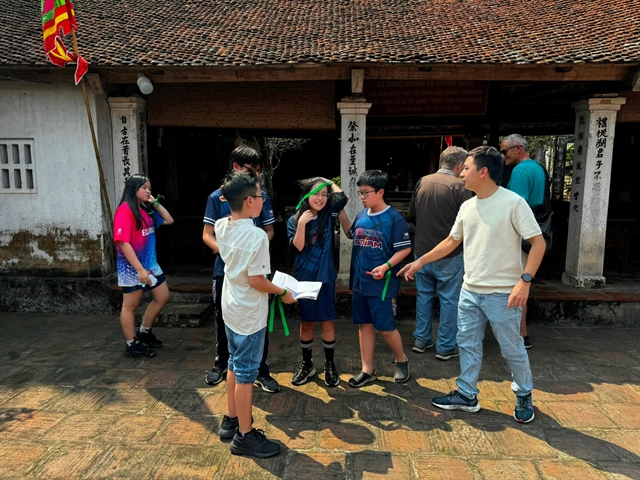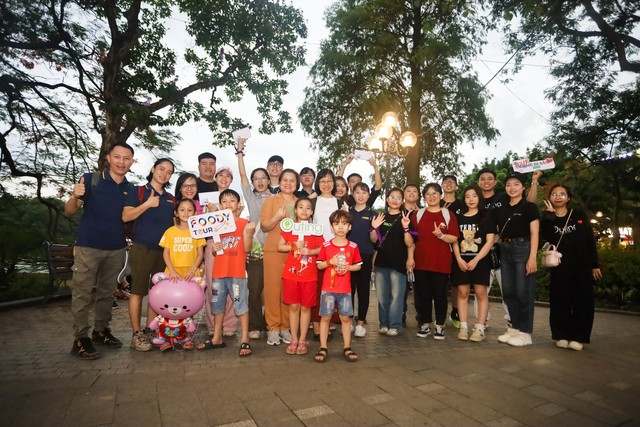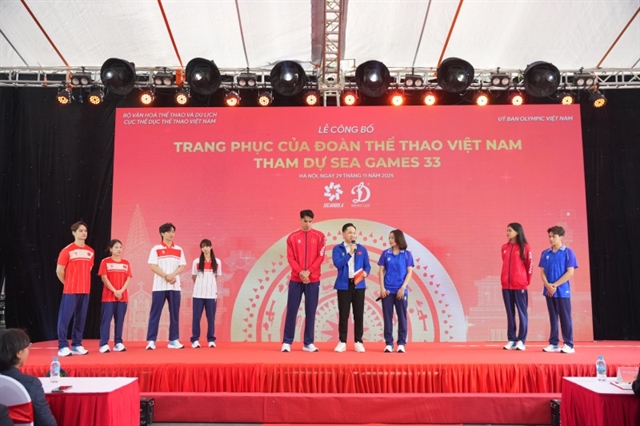 Sunday/Weekend
Sunday/Weekend

 |
| ON TOUR: Tourists join a heritage game tour at the Đường Lâm Ancient Village in Sơn Tây Town, about 44km west of central Hà Nội. Photo toquoc.vn |
Heritage gamification – a new trend promoting national culture and historical legacies – has increasingly emerged as an effective way to boost tourism development in the country.
More and more visitors, particularly the young, are choosing to experience games provided during their visits. These games offer fruitful information and images about the heritage sites they are visiting.
In these games, heritage sites are accurately and meticulously recreated to enhance visitors' excitement and interaction with the relics. For instance, with a simple login and following the instructions on an app, six teams of tourists can join a game that involves overcoming 10 challenges associated with the ancient village of Đường Lâm, a renowned heritage site in Sơn Tây Town, about 44km west of central Hà Nội.
The app guides the route to various destinations within the heritage site. Upon arrival, it provides information about the location and assigns missions and challenges tied to the site's unique features. The app presents questions and suggests answers, enabling players to explore and experience more about the site.
Players who successfully navigate the games can enrich their knowledge about Đường Lâm, the first ancient village in Việt Nam recognised as a national historical and cultural heritage site in 2006.
 |
| GAME TIME: Students participate in a heritage game in Đường Lâm Village. Photo courtesy of the village's management board. |
The village is renowned for its giant banyan trees, communal house, old fresh water wells, rice fields, pagodas, and shrines. It is also famous for traditional candies such as kẹo lạc and kẹo vừng, made of sugarcane molasses, peanuts and sesame.
Experts said gamification is a promising new direction for tourism development, offering more opportunities to promote the country's culture and history in a creative and engaging way.
Nguyễn Đăng Thạo, director of the Management Board of Đường Lâm Village, told the Đại Đoàn Kết (Great Unity) newspaper that heritage gamification has opened up a new approach to attracting more tourists, including young people, to visit the heritage site.
"In the coming time, we will focus on building more game products based on traditional heritage values, providing visitors with new experiences when they come to Đường Lâm," Thạo said.
According to Phạm Hải Quỳnh, director of the Asian Tourism Development Institute, gamifying heritage sites in Việt Nam is not only a new direction for tourism development but also offers opportunities for recreating and promoting the country's culture and history in a creative and attractive manner.
"By combining modern technology and traditional cultural heritage, gamification projects have helped open up a new form of cultural publicity. They attract tourists, particularly young people, while contributing to cultural preservation and education," Quỳnh said.
"Moreover, this trend is a strong driving force for the development of the cultural industry, expanding its influence and creating economic value for the country."
 |
| FOR ALL AGES: Visitors, mostly the young, experience the heritage game tour to explore Hà Nội's Old Quarter. Photo toquoc.vn |
Nguyễn Bá Tùng, director of the Outing Technology JSC, noted: "In the tourism industry, most tourists typically enjoy their travel experiences passively. However, they now want to immerse themselves in tourism activities at each destination."
Tùng said that in response to this trend and with the advancement of technology, his company had developed games based on the culture and heritage of each destination through a mobile application (Outing app), offering tourists more engaging and meaningful experiences.
He emphasised the benefits of heritage gamification, saying that it provides unique experiences for tourists and plays a crucial role in preserving and developing national cultural values.
According to Tùng, gamification enriches visitors' knowledge and raises awareness about cultural values in a modern context by transforming cultural heritage into interactive experiences. It brings heritage to life and makes it more relatable to the public, especially the younger generation.
Tùng and his team have created many heritage game tours, including those at Đường Lâm Village and the Hùng Vương Museum, which have become popular with both domestic and foreign tourists.
Many visitors to the Hùng Vương Museum in Việt Trì City, in the northern province of Phú Thọ, are excited to participate in a role-playing game tour called "Code from Antiquities".
After downloading the heritage gamification application, they embark on an adventure, searching for codes within the museum. The players must solve puzzles related to antiquities discovered in the ancestors' land. Each solved puzzle reveals stories about the nation's history, culture, and famed figures.
"Given the popularity of these new tour styles among locals and foreigners, we are currently developing more heritage game tours at tourist destinations such as Hà Nội, the Museum of Ethnology, and the Việt Nam Village for Ethnic Cultures," Tùng said.
 |
| SOLVING RIDDLES: Young tourists try to solve questions in a heritage game during their sightseeing tour of Đường Lâm Village. |
In Việt Nam, heritage gamification began over 10 years ago with the TV game show Hà Nội 36 Phố Phường (36 Ancient Streets in Hà Nội), which pioneered the combination of entertainment and education.
The program introduces and showcases images and stories about the 36 streets in Hà Nội's Old Quarter, aiming to raise local cultural pride and enhance understanding of the capital's historical and cultural heritage.
Experts said the trend continued to develop and expand, providing a sustainable direction for the tourism industry and the preservation of historical and cultural heritage in the technology era. However, they also highlighted that the strong development of heritage gamification presented many challenges, one of the biggest being ensuring the accuracy and respect of cultural heritage.
"Recreating heritage in a virtual environment requires a deep understanding and respect for local culture and history. Additionally, the financial and technological resources needed for quality heritage games can be a barrier, especially in developing countries like Việt Nam," Director Quỳnh said.
"To promote the future development of heritage gamification, it is crucial to foster cooperation between authorities, cultural organisations, and game developers to ensure that these projects are not only engaging but also accurate and respectful of cultural values." VNS




